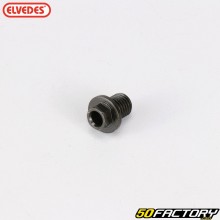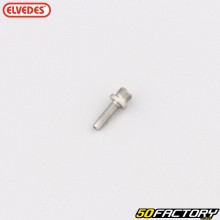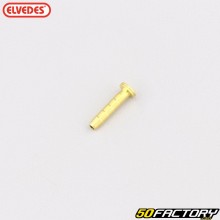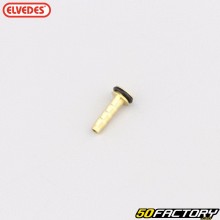 Caliper parts
Caliper parts
- IN STOCK0€70
- IN STOCK0€70
- IN STOCK1€00
- IN STOCK1€40
- IN STOCK3€30
-
-
-
-
-
- IN STOCK0€90
- IN STOCK1€10
- IN STOCK0€80
- IN STOCK4€80
-
-
-
-
- IN STOCK0€70
- IN STOCK4€10
- IN STOCK12€40
- IN STOCK1€40
-
-
-
-
-
- IN STOCK0€50
-
- IN STOCK1€40
- IN STOCK6€80
-
- IN STOCK5€00
Understanding the role of stirrup parts for VTC trekking
The importance of these elements
Brake calipers are essential to ensure efficient and safe braking on trekking VTC bikes. They are responsible for applying the force braking on the wheels by pinching the disc or rim, which slows or stops the bike. A high-performance braking system is vital for your safety, especially when hiking on varied terrain. In addition, the efficiency of your braking can also have an impact on your riding comfort and the handling of your trekking VTC.
The different parts of a brake caliper
A brake caliper on a trekking bike is made up of several key components: the brake levers, cables (for mechanical systems), calipers, brake pads and discs (for hydraulic systems). Each component has a specific role and their proper functioning together ensures optimal braking performance. Understanding the role of each of these elements and how they interact with each other will help you better understand the importance of choosing quality trekking bike caliper parts that are suitable for your bike.
Types of parts
Mechanics and hydraulics: characteristics and differences
There are two main types of brake calipers for trekking bikes: mechanical and hydraulic. Mechanical brakes work with cables that pull the calipers to pinch the pads against the rotor or rim. They are generally simpler and less expensive, but can require more maintenance. They are ideal for riders who prefer to have complete manual control over their braking and don’t mind a little maintenance.
Hydraulic brakes, on the other hand, use fluid to transfer the force brake lever to caliper. They offer superior stopping power and finer modulation, but are often more expensive and complex to maintain. They are ideal for those who want powerful braking with minimal lever effort, and who do not mind more technical maintenance.
Choosing between a center-pull and side-pull device
Brake devices can also be classified into two categories according to their pull mode: central or lateral. Central pull brakes, often used on road bikes, offer a balanced distribution of force. force Braking. Side-pull brakes, more common on mountain bikes and hybrid bikes, offer easier installation and simplified maintenance. It is important to choose the type of pull that best suits your riding style and bike for the best braking experience.
The choice according to the trekking conditions
Finally, the choice of component type may also depend on the conditions in which you plan to trek. For long distances on difficult terrain, hydraulic brakes might be a better option thanks to their superior stopping power. For more urban use or on less demanding terrain, mechanical brakes might suffice.
Choosing the Right Caliper Parts
The criteria to be taken into account
Choosing the right caliper parts for your trekking bike depends on several factors. First, consider the type of bike and the type of brakes you use. Next, think about the type of terrain you ride on most often. For rough and mountainous terrain, hydraulic brakes might provide better performance. For urban commutes and flat roads, mechanical brakes might suffice. It's also important to consider the weather conditions you'll be facing. Hydraulic brakes may be more effective forar rainy weather, par example.
Parts compatibility
Part compatibility is key. Make sure the brake calipers you choose are compatible with your bike model. Check the manufacturer's specifications or seek expert advice to avoid any installation or performance issues. Don't forget to also check your wheel size, which isar it can influence the type of caliper needed. If in doubt, do not hesitate to contact our customer service for personalized advice.
The quality of the parts
Finally, it is crucial to prioritize quality. Good quality caliper parts ensure optimal performance and greater longevity. At 50 Factory, we offer you high quality parts, rigorously selected for their robustness and reliability.
Installation
Preparation and necessary tools
Installing caliper parts on a trekking bike requires some specific preparation and tools. You will need brake levers, cables or hoses, calipers, pads, a set of Allen keys, pliers, and possibly a bleeder for hydraulic systems. It is also advisable to have a clean and well-lit workspace to facilitate the process.
Installation steps
Here are the general steps to install a stirrup part on your trekking VTC:
- Prepare the bike: Make sure the bike is clean and stable. A bike stand might be helpful to keep the bike at a comfortable height during installation.
- Secure the brake levers: Install the brake levers on the handlebars and adjust them to a comfortable position.
- Install the calipers: Mount the brake calipers onto the fork or frame brackets. Make sure they are properly aligned and securely fastened.
- Connect the cables or hoses: For mechanical brakes, attach the cables to the levers and calipers. For hydraulic brakes, connect the hoses and bleed the system to remove air bubbles. Always follow the manufacturer's instructions for this step.
- Adjust the pads: Make sure the brake pads are properly aligned and adjusted for optimum contact with the rotor or rim. Improper alignment can result in premature wear and reduced braking performance.
- Test the system: Once installation is complete, test the brake system to ensure it is working properly. Test it on a safe road before setting out on a ride.
Safety and Precautions
Remember that working on your bike's brake system is a delicate task that requires precision and attention. If you are not sure you can do it correctly, do not hesitate to call a professional. A poorly installed brake system can compromise your safety.
Care instructions
Maintenance Tips
Regular maintenance is crucial to ensure the longevity and performance of your trekking bike's stirrup parts. Here are some maintenance tips:
- Clean regularly: Prevent dirt and debris from building up on calipers and pads.
- Check for wear: Inspect pads and rotors for signs of wear and replace if necessary.
- Lubricate the cables: For mechanical systems, lubricate cables to ensure smooth operation.
- Bleed the hydraulic systems: For hydraulic brakes, bleed the system regularly to prevent air bubbles and maintain optimum performance.
Tips for extending the life of caliper parts
In addition to regular maintenance, there are certain practices that can help extend the life of your trekking VTC stirrup parts. Par For example, avoid braking suddenly or continuously,ar This can cause premature wear of the pads and discs. Also, after a ride in wet or muddy terrain, take the time to clean and dry your calipers to avoid corrosion. Finally, store your trekking VTC in a dry place, protected from bad weather to preserve the quality of your parts.
Signs of wear
Signs of worn caliper parts include decreased braking power, squealing noises, vibrations when braking, and visibly worn brake pads. If you notice these signs, it's time to replace the worn parts to ensure your safety.








































